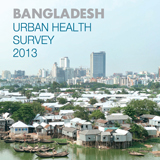
Bangladesh is undergoing a rapid urbanization process. While the rural population is expected to peak at 105 million people in 2016 (just two years from now) and then decline1, the urban population will grow from its current level of 53 million people to 79.5 million in 2028, an increase of 50% in 14 years1 (Figure 1). From being a largely rural country now (66.5% of the population lives in rural areas in 20141), Bangladesh will be an urban country in 2039 when the majority of people will live in urban areas. Most of this growth is driven by migration from rural areas. Cities are characterized by large inequalities in health-related conditions. About one third of the urban population lives in slums, which are areas that exhibit pronounced concentrations of factors that negatively affect health and nutrition. The Urban Health Survey (UHS) 2013, and a similar survey conducted in 2006, were designed to examine the conditions of the urban population of Bangladesh with explicit attention to look at differences between slum and non-slum groups.
The objectives of the UHS 2013 are:
- To measure changes in key health outcomes and service utilization indicators in major urban domains of Bangladesh, namely, in slums and non-slums of City Corporations, and other urban areas
- To examine sources of care for various health services in slum and non-slum areas
- To examine whether intra-urban differences in key health outcomes have narrowed between 2006 and 2013.